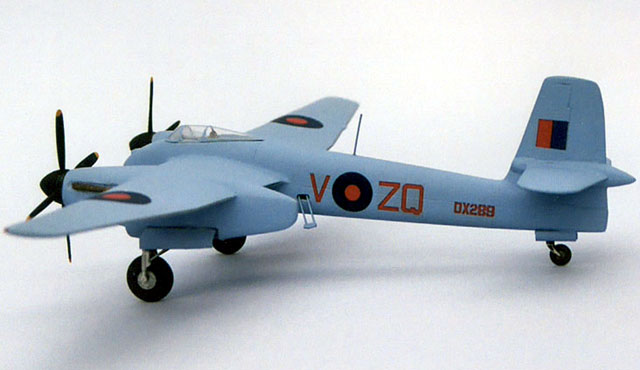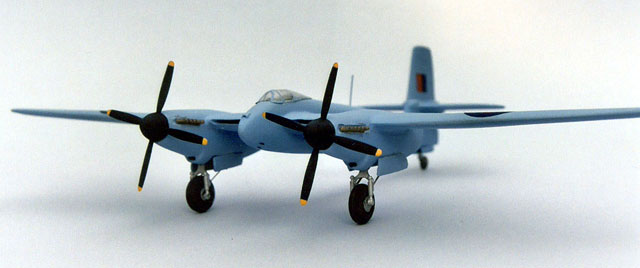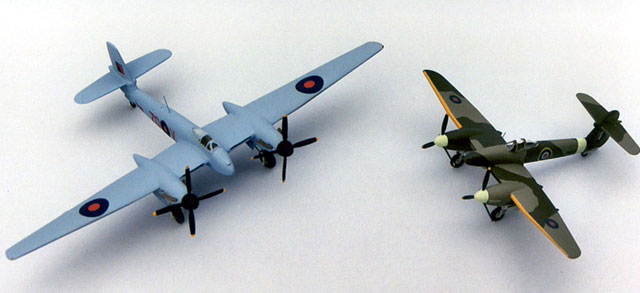|
Westland Welkin F.Mk.1
by Tom Conte
|

|
|
Westland Welkin F.Mk.1 |

HyperScale is proudly supported by
Squadron.com
While the Welkin pasted into history without playing any notable
role during World War Two, one its technological achievements still
lives on today.
The aircraft was the British response to the high altitude
threat of German aircraft. At the time a major hurdle to
stratospheric flight was how to keep a pilot alive. Besides
providing oxygen to breath, a pilot needs to operate in an
environment equivalent to being under 10,000 feet in altitude or he
would soon pass out. The designers at Westland developed a
pressurizing system that maintained the pilot in reasonable comfort
up to the service ceiling of 44,000 feet. It is this original
concept in cockpit pressurization that the Welkin contributed to
aviation and is still in use today.

The rest of the aircraft components were not as successful in
accomplishing their design goals and had problems that could not be
resolved before the end of the war. The armament consisted of four
20 MM cannons in a belly mounted tray. Power was provided by two
Rolls-Royce Merlins driving superchargers. It was briefly considered
for reconnaissance, but never was deployed in that role.
Hallam
Vac 1/72 Scale Welkin
|
This is a nearly twenty year old Hallam-Vac 1/72 scale
vacuformed kit. It came with decals, a clear canopy, metal landing
gear, props, and engines exhaust. When I came across information
about the aircraft even earlier, my first thought was that I had to
scratchbuild it. I liked the looks of the long wings and its overall
blue finish. Maybe my being a sailplane pilot had something to do
with it. Like everything else the project got pushed back until I
discovered the kit and bought it thinking this will be a quick and
easy project.
The model is a fairly simple build but the challenge was to get
the radiators intakes right. For streamlining, the engineers mounted
the engine coolant radiators inside the wings. The air needed for
cooling was brought in through openings in the wings leading edge
between the engines and fuselage.
The modeling problem was that the kit’s plastic was too thin and
soft and it was difficult to create the two openings. I was
beginning to think I should have scratchbuilt the model starting
with better material. One solution was to graft on a section of
harder plastic after creating the opening by laminated the pieces.
However filing the new section to match the wing’s profile was time
consuming. The second solution, which although seemed much simpler
almost turned fatal!

Superglues or CA when cured result in a hard material. The plan
was to fill the inside of the wing with CA and when harden, use a
power grinder to carve the opening. The second the grinding disk
touch the wing however, I quickly recalled a hazard material class
and realized the little puff of smoke coming from the model was a
very deadly gas! The CA in superglue stands for cyanoacrylate, which
when exposed to heat is not healthy at all. Who said that model
building is not exciting! Needless to say, the intakes were
completed by slow hand filing and left in a “good enough” condition.
The rest of the model went together quickly, I added a wooden
spar to strengthen the long wings and opened the cannons’ ports and
inserted plastic tubing. These were then blended into the belly. All
of the metals parts were superglued into place after the paint was
removed from their mounting location.
 The
Welkin was finished in Testor’s Model Master paints, given a gloss
coat for decals, and finally sprayed in Testor’s Dullcote . The
Welkin was finished in Testor’s Model Master paints, given a gloss
coat for decals, and finally sprayed in Testor’s Dullcote .
In the image below I have a Westland Whirlwind next to the
Welkin for comparison.

Over the years, I have seen many discussions that it might be
possible to convert the Whirlwind into a Welkin. That image should
remove any thoughts in attempting that project. The Welkin’s the 70
foot wingspan in 1/72 scale results in the model’s wings being
nearly a foot long.
Finally having a Welkin in the collection adds a totally
different shape and color and a new piece of old technology.
Review and Images Copyright © 2002 by
Tom Conte
Page Created 31 August, 2003
Last updated
17 March, 2004
Back to HyperScale Main
Page
Back to Reviews
Page
|
Home |
What's New |
Features |
Gallery |
Reviews |
Reference |
Forum |
Search